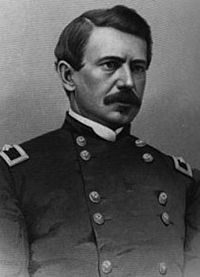Richard Arnold (general) facts for kids
Quick facts for kids
Richard Arnold
|
|
|---|---|

Major General Richard Arnold
|
|
| Born | April 12, 1828 Providence, Rhode Island, U.S. |
| Died | November 8, 1882 (aged 54) New York City, New York, U.S. |
| Place of burial |
Swan Point Cemetery, Providence, Rhode Island
|
| Allegiance | United States of America Union |
| Service/ |
United States Army Union Army |
| Years of service | 1850–1882 |
| Rank | |
| Battles/wars | American Civil War |
| Relations | Isaac P. Rodman (brother-in-law) Benedict Arnold |
- For other people of the same name, see Richard Arnold (disambiguation).
Richard Arnold (born April 12, 1828 – died November 8, 1882) was an officer in the U.S. Army. He became a brigadier general for the Union forces during the American Civil War. His skills with artillery (large cannons) helped the Union win important battles. He played a key role in forcing two Confederate towns to surrender, including Mobile, Alabama.
Early Life and Education
Richard Arnold was born in Providence, Rhode Island, in 1828. His father, Lemuel Arnold, was a governor of Rhode Island and a member of the U.S. Congress.
Richard went to the United States Military Academy and graduated in 1850. Some of his classmates, like Eugene Asa Carr and Cuvier Grover, would later fight alongside him in the Civil War. Before the war, Arnold served in different military posts. He was stationed in places like Florida, California, and the Pacific Northwest. He was promoted to captain and worked as an aide-de-camp (a personal assistant) for Major General John E. Wool.
Service in the Civil War
When the Civil War began, Richard Arnold was in charge of an artillery unit. At the First Battle of Bull Run, his unit was part of a Union retreat, and they had to leave their cannons behind.
In 1862, he worked in various staff roles with the Army of the Potomac. He was a chief of artillery for a division and an assistant inspector for the VI Corps.
After the Seven Days Battles, Arnold was promoted to brigadier general of volunteers. He was then sent to the Army of the Gulf, where he became the Chief of Artillery. He held this important job for two years.
During the Siege of Port Hudson, Arnold directed the cannons that surrounded the fort. His artillery helped make the fort and town surrender. Later, he also commanded the artillery that led to the surrender of Mobile, Alabama. For his bravery and success, he received a special promotion called a brevet promotion to major general in March 1865. This meant he had the rank of major general, but not the pay or full command of that rank.
After the War
After the Civil War ended, Richard Arnold returned to his regular army rank of captain. He served in different posts with the 5th U.S. Artillery. In 1875, he was promoted to major.
In 1882, while he was stationed on Governors Island in New York City, he received another promotion to lieutenant colonel. However, he sadly passed away just five days later. He was buried in Swan Point Cemetery in Providence, Rhode Island.
Family Connections
Richard Arnold's brother-in-law, Isaac P. Rodman, was also a Union Brigadier General. General Rodman was badly wounded at the Battle of Antietam and later died from his injuries.
Legacy
A ship from World War II, the USS Dick Arnold, was named in honor of General Richard Arnold. Sadly, this ship sank in January 1942 during a storm off Portsmouth, New Hampshire, and ten sailors lost their lives.

